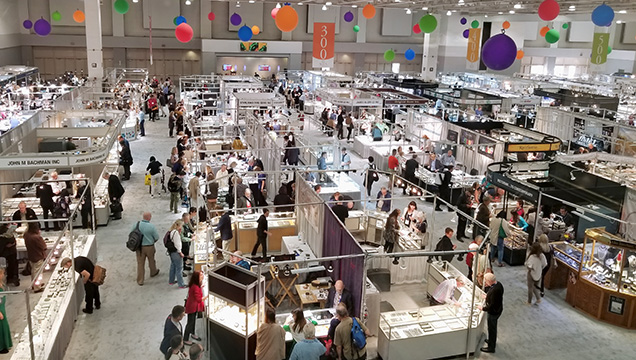Tucson 2019 Overview

The 2019 gem shows came to Tucson with a wealth of material, both new and old, as eager buyers descended on exhibitors to take in the latest trends. While traffic was not as heavy as in recent years, several vendors noticed an influx of young people looking for natural, untreated gemstones. Spectacular color in gems and stunning jewelry designs were on view, while many pointed to sustainable and ethical practices as a major consideration in their colored gemstone and jewelry purchases.
The Asian market has slowed, according to Edward Boehm of RareSource (Chattanooga, Tennessee), and as a result, gems that have been popular in Asia, particularly China, are starting to gain traction in the United States. Boehm indicated that the growth of the Asian market is still driving production in African countries, particularly Nigeria, and Americans are the primary consumer of this increased production. Improving exchange rates have also worked in the American market’s favor. Dave Bindra (B&B Fine Gems, Los Angeles) said that while higher-end gemstones are still difficult to come by, they are as much in demand as ever. Commercial-grade gems, Bindra noted, have become more accessible. Like Boehm, he attributes this in large part to activity in the Chinese market in recent years. Shahin Aboosalih of SR Trading’s Hong Kong office talked to us about material that remains popular in the Chinese and Japanese markets.

Opal, particularly black opal, has seen a resurgence among high-end jewelers. Boehm believes there could be a growing appreciation for the gem due to the discovery of opal in Ethiopia, which has brought opal to different price points and different audiences in the past decade. Rod Griffin (Rod Griffin Boulder Opals) discussed his experiences in Australian opal mining and the new technology he is using to exploit deposits once thought to be depleted.
Color, of course, continues to reign, and dealers are seeing what Boehm called “an increased appreciation for the unusual.” Beyond the classic “Big Three,” vendors stocked gemstones such as sphene, grandidierite, and various colors of sapphire. Color-change stones seen in previous shows, such as pyrope garnet and alexandrites, were also on display and drawing new attention. Cutters, he noted, are making strides in recognizing and using to different effect specific phenomena in gemstones, such as the trichroism of tanzanite. Spinel remains the most popular “new” gem, according to Boehm, especially in nontraditional colors such as lavender and violet, which would have been cut too dark (or not at all) in the past. Gray spinel in particular made a splash at this year’s show, with several exhibitors stocking the material in a variety of cuts.
Brian Cook of Nature’s Geometry (Tucson) noticed a cross-pollination between the mineral and jewelry industries, with more designers and jewelers using raw euhedral stones to create unique looks. He also noted that several new mineral shows, developed out of dealers’ collectives rather than sponsored by one promoter, have come to the city and seem to be here to stay. The popularity of the Granada Gallery, which prides itself on its dedication to “fine natural design,” is one such indicator.
American gemstones were also in heavy rotation at the shows. Eric Braunwart of Columbia Gem House, who has long stocked American production in his inventory, said that sales of these products were good. Designer Derek Katzenbach discussed his use of American gemstones such as Maine tourmaline. And among the material seen was Montana sapphire, nephrite from Washington State, Oregon sunstone, and hyalite opals from Oregon.
Bindra noted that many of his company’s rare gems came out of the ground 20–30 years ago, and that he relies heavily on the secondary market to procure such material. In this way, he is able to provide his clients with the high-end material they have come to expect. This sentiment was echoed by Jared Holstein of Perpetuum Jewels, a wholesaler working with antique diamonds and colored stones in historical cuts for the bridal market. Holstein also finds the secondary market to be a good way to source gemstones in an ethical and environmentally sustainable fashion.
Responsibly sourced material continues to be heavily sought after. Braunwart said this might have been his most successful show in his 41 years at Tucson. He credits this in large part to his commitment to providing fair trade, responsibly sourced gemstones. Susi Smither, who founded The Rock Hound specifically to create an ethical jewelry line, delighted in showing us her Molten Muzo collection, which used responsibly sourced Colombian emeralds and recycled gold. And gem dealer and jewelry designer Roger Dery told us about Gem Legacy, the nonprofit he founded to benefit East African mining communities.
We hope you enjoy our coverage of the 2019 Tucson gem shows!
The following contributed to this report: Erin Hogarth, Tao Hsu, Jonathan Muyal, Lisa Neely, Aaron Palke, Duncan Pay, Albert Salvato, Kevin Schumacher, Jennifer Stone-Sundberg, Wim Vertriest, and Robert Weldon.














